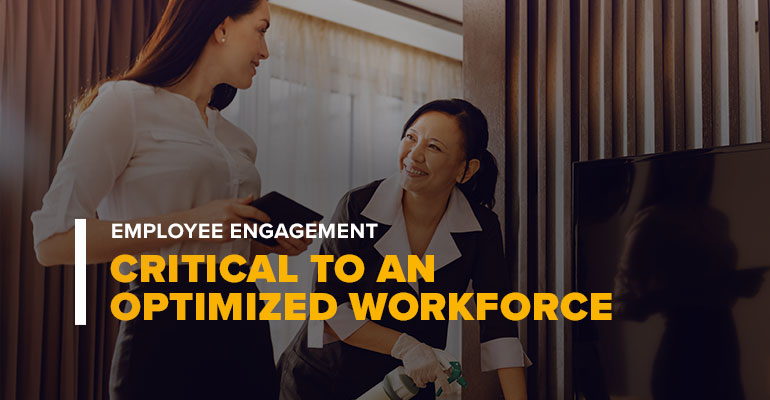November 17, 2019 - Published in Hotel Business Review - Think about the last time you asked someone about their experience at a restaurant or hotel. Likely, their response included not just their thoughts on the quality of the food or the comfort of their room but the service as well. Were employees courteous? Efficient? Did they anticipate the guest's needs? Because whether one's talking about a Chili's or Spago, a Best Western or a Four Seasons, a key driver of guest satisfaction is the staff.
An engaged server-one who is committed to the success of the organization and passionate about representing it well-will result in higher-quality service delivery and greater satisfaction. And as any hotelier knows, a satisfied guest is more likely to return and recommend the business, ultimately driving top-line revenue.
For a service business, intent to return and recommend is the dependent variable of optimized performance, because achieving that level of customer satisfaction hinges on one's workforce. Every aspect of workforce performance-skills, availability, timing and attitude-must align in order to meet the customer's expectations. In the hotel environment for example, UniFocus has found that a 10% increase in employee engagement scores among our customers translates to an average increase of $50,000 to $70,000 in room revenue for a 100-room limited service property.
Engagement is at a High-But Not High Enough
Here's the good news: According to a 2018 Gallup poll, the ratio of engaged to actively disengaged U.S. workers is at its highest-2.6 to 1-since Gallup first tracked engagement levels in 2000. The percentage of engaged workers now ties that of the poll's inaugural year at 34%, while the percentage of actively disengaged is at a record low of 13%. Gallup attributes this increase in engagement to two factors: higher worker confidence that they have a choice in where they work, thanks to an improved economy, and a management approach that has shifted to coaching workers based on their strengths.
The bad news is that the remaining U.S. workers-a majority, at 53%--fall into the "not engaged" category. And lack of engagement has a recognized negative impact on everything from productivity, teamwork and turnover to customer satisfaction.
An Expanded Definition of an Optimized Workforce
Some say an optimal operation is one that delivers least-cost, consistent customer service based on the target market. However, it also must take into account the indirect services that impact the overall guest experience-and that includes maintaining the quality of the asset. For example, guests might enjoy an excellent check-in experience at a hotel, but if they see duct tape holding down the carpet or crumbs on a chair cushion as they pass through the lobby, that will negatively impact their overall perception of service-likewise, if they enjoy a fine dinner only to find an empty soap dispenser in the restroom.
Such cracks in the customer experience can often be attributed to staffing issues, and those, in turn, either result from or contribute to low engagement levels.
Managerial Attitudes Influence Employee Attitudes
One of the first places a hotelier should look to improve the attitude of employees is the attitude of their managers. There's a strong correlation (.7) between engagement and workers' perceptions of their leaders. An engaged manager who interacts positively with his or her team has a positive impact on engagement levels within that team-and with the arrival of the millennial majority workforce, the terms of those interactions is changing. Among the insights from the Gallup poll was that engagement is on the rise in part because today's managers, in response to the needs of their millennial employees, are shifting the way they interact with workers to focus on strengths.
Right Staffing
We often say that an optimized workforce is one that delivers the right number of people at the right time with the right skills and the right attitude. That statement implies that engagement and right staffing are distinct measures. But engagement is also influenced by right staffing. When shifts are consistently understaffed, employees become demoralized. Workers can arrive for a shift with the best attitude but if only seven of a team of 10 show up, those seven will have to work harder, which will likely leave them frustrated. They will also have to work faster, increasing the likelihood that certain aspects of their work will fall by the wayside.
When that happens, too often what's sacrificed is the employee's interaction with customers. Therefore, a more accurate statement about optimization is this one: Right staffing coupled with the semi-dependent variable of engagement drives the fully dependent variable of customer satisfaction.
While the costs of understaffing on employee morale are fairly obvious, overstaffing also diminishes engagement. If a restaurant needs six servers to properly staff a shift but schedules nine, the activity level is lower. Workers become less focused on their tasks and interact more with each other and less with customers. Who among us hasn't had the experience of being served in a restaurant with many empty tables only to find it more difficult to get a server's attention than it would be if the restaurant was busier?
Another benefit of right staffing is that tips are distributed in an ideal way. Understaffing results in substandard customer service which can lead to lower than average tips, while overstaffing dilutes the tipping pool. So right staffing-having the right number of people with the right skills at the right time-provides a level of customer service that leads to optimal tipping, which helps sustain engagement. And it's that engagement factor that, in turn, can push the customer experience over the finish line.
The Right Supplies
Right staffing also helps ensure that workers have the right supplies at their fingertips to do their job efficiently. If a shift is understaffed, employees might not have time to take care of activities such as stocking a side station in a restaurant or organizing a linen closet in housekeeping. Those inefficiencies lower engagement further and ultimately have a negative impact on customer satisfaction. For example, if a housekeeper has to spend extra time locating linens or begins to clean a room only to find the vacuum isn't working, it reduces the amount of time he or she can devote to cleaning. That housekeeper is then more rushed and more liable to miss a detail or two, leading to a diminished sense of accomplishment and lower morale. What's more, they're less likely to notice and greet a guest passing by in the hallway, negatively influencing the guest's perception of the hotel's service level.
External Factors
Disney theme parks refer to employees as "cast members," and the reality is that all workers in customer-facing positions are, on some level, performers. They are expected to interact with customers with enthusiasm and a smile no matter their mood. Workers in non-customer-facing jobs are also often adept at leaving their outside issues at the door and presenting their "show" face at work. However, even if those outside issues aren't impacting an employee's demeanor or competence on the job, they very well might prevent him or her from being fully engaged.
For managers, the challenge is to not mistake good performance for real engagement. And that leads to two questions: What is a manager's responsibility to recognize that an employee might be dealing with external factors that affect his or her ability to engage at work? And how does an organization build a culture that not only drives a sense of being "on" every day, but contributes to a high level of engagement for those employees who arrive at work distracted? The answer is the manager must be engaged with his or her employees, at times simply by "catching up" on a daily basis to clearly demonstrate that the team is in it together.
To Increase Engagement, Focus On Your Engaged Employees
Disengagement is a contagion and hoteliers are right to address it as disengaged workers can bring down engagement levels of those around them. However, managers make a mistake when they spend too much time focusing on the concerns of their disengaged or partially engaged employees and less time on those of their engaged workers. In doing so, there's a real risk of allowing their engaged workers to slip downward. The better approach is to focus more effort on their engaged employees, and as those employees become more successful, they will pull their partially engaged colleagues up.
Keeping Millennials Engaged
Much has been written about the rise of the millennial generation and how the expectations they have brought to the workplace differ from those of previous generations. Their priorities range from better work/life balance to greater control in managing their schedules. And as more millennials step into managerial roles, they are already reshaping the management culture in that direction. Giving them the tools to do so-in particular, enabling them to, when appropriate, select shifts and interact with their managers and other team members from their smartphones-will lead to improved communication and higher job satisfaction.
Smartphones also provide managers with the means to monitor engagement on an ongoing basis, gleaning feedback from pulse surveys that can be deployed on short notice and require little effort from responding employees. In fact, data across a wide variety of UniFocus' clients in the hospitality industry confirms that hotels that regularly measure engagement of their employees, and take action on the results, perform consistently better than those that don't.
Click here to read the original article in Hotel Business Review






